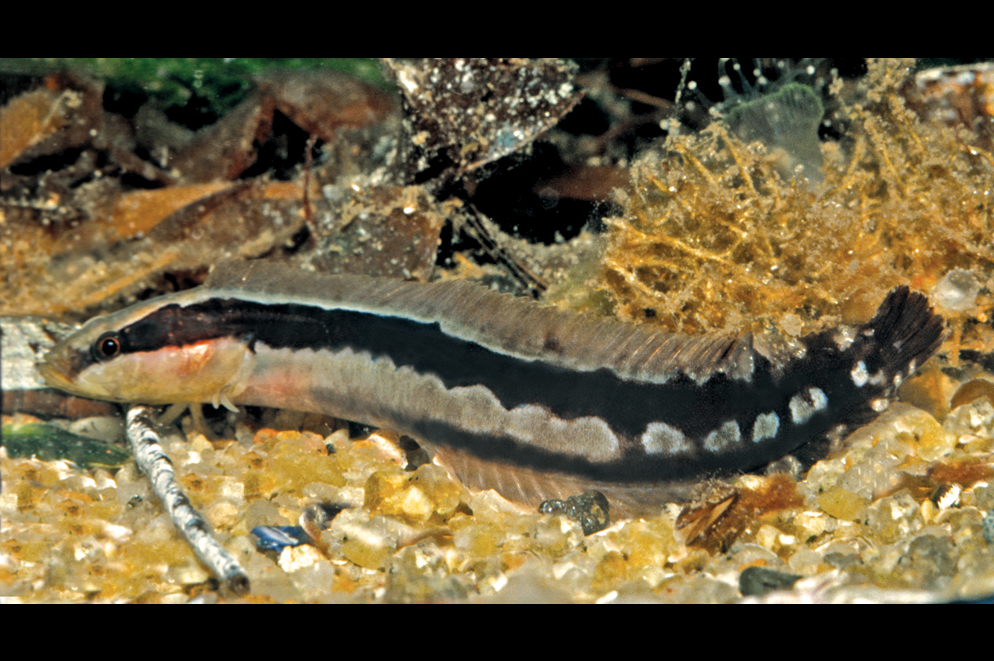Blackback Snake Blenny, Ophiclinus gracilis Waite 1906
Other Names: Blackback Snakeblenny, Black-back Snake-blenny, Black-backed Snake Blenny, Black-backed Snake-blenny, Dark Backed Snake Blenny

A Blackback Snake Blenny, Ophiclinus gracilis. Source: Rudie H. Kuiter / Aquatic Photographics. License: All rights reserved
Summary:
An orange to whitish snake blenny with an irregular broad dark brown stripe along the upper side from the snout through the eye to the upper part of the tail base, paler spots and patches along the middle rear of the body, and brownish dorsal and anal fins with alternating dark and pale patches posteriorly. The caudal fin is brown with an irregular whitish margin, and the pectoral fins are pale dusky.
Cite this page as:
Bray, D.J. 2022, Ophiclinus gracilis in Fishes of Australia, accessed 27 Jun 2024, https://fishesofaustralia.net.au/Home/species/1106
Blackback Snake Blenny, Ophiclinus gracilis Waite 1906
More Info
|
Distribution |
Broken Bay, New South Wales, to the Houtman Abrolhos, Western Australia, including around Tasmania. Inhabits shallow coastal waters, including rock pools and silty areas, often under rocks and stones, and among seagrass detritus. |
|
Features |
Dorsal fin XLIV-XLIX, 1; anal fin II, 27-31; Caudal fin 13-14; Pectoral fin 11-13; Pelvic fin I, 2. Body slender (14-16% SL), very elongate, compressed, gradually tapering to shallow caudal peduncle. Head small (19-22% SL); eyes small (16-19% HL); tube of anterior nostrils with fleshy flap at tip; mouth small (upper jaw length 35-40% HL), nearly horizontal, maxillae reaching slightly beyond hind edge of eyes; teeth conical, moderately large, band at front of each jaw, single row laterally; roof of mouth with one or two curved rows of teeth. Scales tiny, cycloid, not overlapping; lateral line not associated with scales, consisting of 15-20 pores originating above opercles, followed by series of pit like depressions; front pore in series of pores running down and forward on each cheek paired. Singular dorsal and anal fins with very elongate bases and fairly uniform heights, both broadly joined by membranes to caudal fin, dorsal arising above rear of opercles, membranes between anal fin rays distinctly notched at edge; caudal fin rounded. Pectoral fins of moderate size, much longer than eye diameter. Pelvic fins much longer than eye diameter, arising slightly in front of and below pectoral fin bases. |
|
Colour |
Orange to white with broad dark brown stripe on upper portion of head and sides from tip of snout and posterior edge of each eye, stripe with narrow white border above and below, becoming somewhat irregular posteriorly encircling paler spots and patches along centre of sides posteriorly; dorsal and anal fins brownish with alternating dark and pale patches posteriorly; caudal fin brown with irregular whitish margin; pectoral fins pale dusky. |
|
Biology |
Species in the family Clinidae are live-bearers. |
|
Etymology |
The specific name is from the Latin gracilis (= slender), presumably in reference to the elongate body of this species. |
|
Species Citation |
Ophioclinus gracilis Waite 1906, Rec. Aust. Mus. 6(3): 207, pl. 36, fig. 6. Type locality: Long Bay, New South Wales. |
|
Author |
Bray, D.J. 2022 |
|
Resources |
Blackback Snake Blenny, Ophiclinus gracilis Waite 1906
References
Edgar, G.J. 2008. Australian Marine Life: the plants and animals of temperate waters. Sydney : Reed New Holland 2nd edn, 624 pp.
George, A. & Springer, V.G. 1980. Revision of the clinid fish tribe Ophiclinini, including five new species, and definition of the family Clinidae. Smithsonian Contributions to Zoology 307: 1-31 figs 1-14 https://doi.org/10.5479/si.00810282.307
Hoese, D.F., Gomon, M.F. & Rennis, D.S. 2008. Family Clinidae. pp. 696-722 in Gomon, M.F., Bray, D.J. & Kuiter, R.H. (eds). Fishes of Australia's Southern Coast. Sydney : Reed New Holland 928 pp.
Hoschke, A., Whisson, G. & Moore, G.I. 2019. Complete list of fishes from Rottnest Island. pp. 150-161 in Whisson, G. & Hoschke, A. (eds) The Rottnest Island fish book. 2nd ed. Perth : Aqua Research and Monitoring Services.
Hoschke, A., Whisson, G. & Moore, G.I. 2021. Complete list of fishes recorded from the Perth Coast (Mandurah to Two Rocks). pp. 262-273 in Whisson, G. & Hoschke, A. (eds) The Perth coast fish book. Identification guide Mandurah to Two Rocks. Perth : Aqua Research and Monitoring Services.
Hutchins, J.B. & Swainston, R. 1986. Sea Fishes of Southern Australia. Complete field guide for anglers and divers. Perth : Swainston Publishing 180 pp.
Kuiter, R.H. 1993. Coastal Fishes of South-eastern Australia. Bathurst : Crawford House Press 437 pp.
Kuiter, R.H. 1996. Guide to Sea Fishes of Australia. A comprehensive reference for divers and fishermen. Sydney, NSW, Australia : New Holland Publishers xvii, 434 pp.
Kuiter, R.H. & Kuiter, S.L. 2018. Fish watchers guide to coastal sea-fishes of south-eastern Australia. Seaford, Victoria : Aquatic Photographics 371 pp.
Last, P.R., Scott, E.O.G. & Talbot, F.H. 1983. Fishes of Tasmania. Hobart : Tasmanian Fisheries Development Authority 563 pp. figs.
Rennis, D., Hoese, D.F. & Gomon, M.F. 1994. Family Clinidae. pp. 741-775, figs 650-684B in Gomon, M.F., Glover, C.J.M. & Kuiter, R.H. (eds). The Fishes of Australia's South Coast. Adelaide : State Printer 992 pp. 810 figs.
Scott, E.O.G. 1936. Observations on some Tasmanian fishes. Part 3. Papers and Proceedings of the Royal Society of Tasmania 1935: 113-129 figs 1-3 (described as Ophiclinus greeni)
Thomson, J.M. 1978. A Field Guide to the Common Sea & Estuary Fishes of Non-tropical Australia. Sydney : Collins 144 pp.
Waite, E.R. 1906. Descriptions of and notes on some South Australian and Tasmanian fishes. Records of the Australian Museum 6(3): 194-210 figs 34-36 https://doi.org/10.3853/j.0067-1975.6.1906.1000 (as Ophioclinus gracilis)
Waite, E.R. 1921. Illustrated catalogue of the fishes of South Australia. Records of the South Australian Museum 2(1): 1-208 293 figs pl. 1 See ref at BHL
Williams, J.T., Holleman, W. & Clements, K.D. 2014. Ophiclinus gracilis. The IUCN Red List of Threatened Species 2014: e.T179036A1562099. http://dx.doi.org/10.2305/IUCN.UK.2014-3.RLTS.T179036A1562099.en. Downloaded on 25 October 2018.





